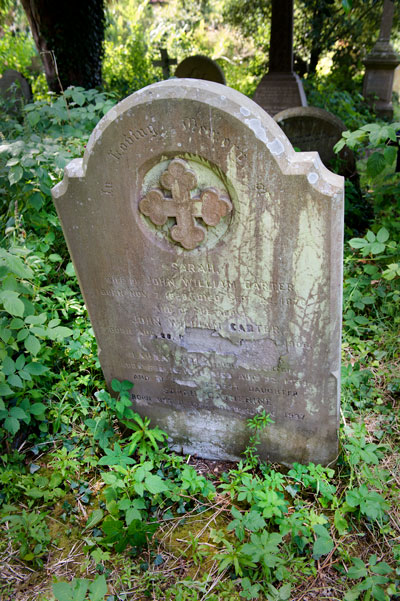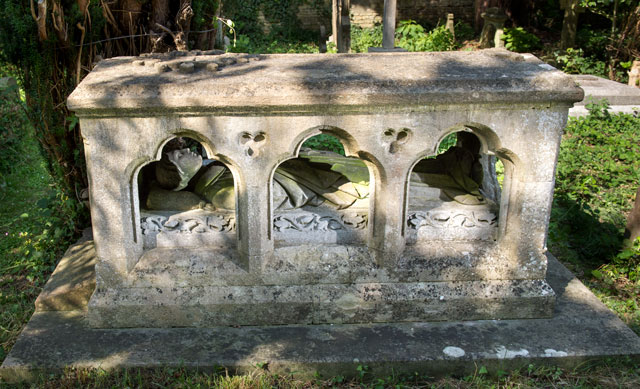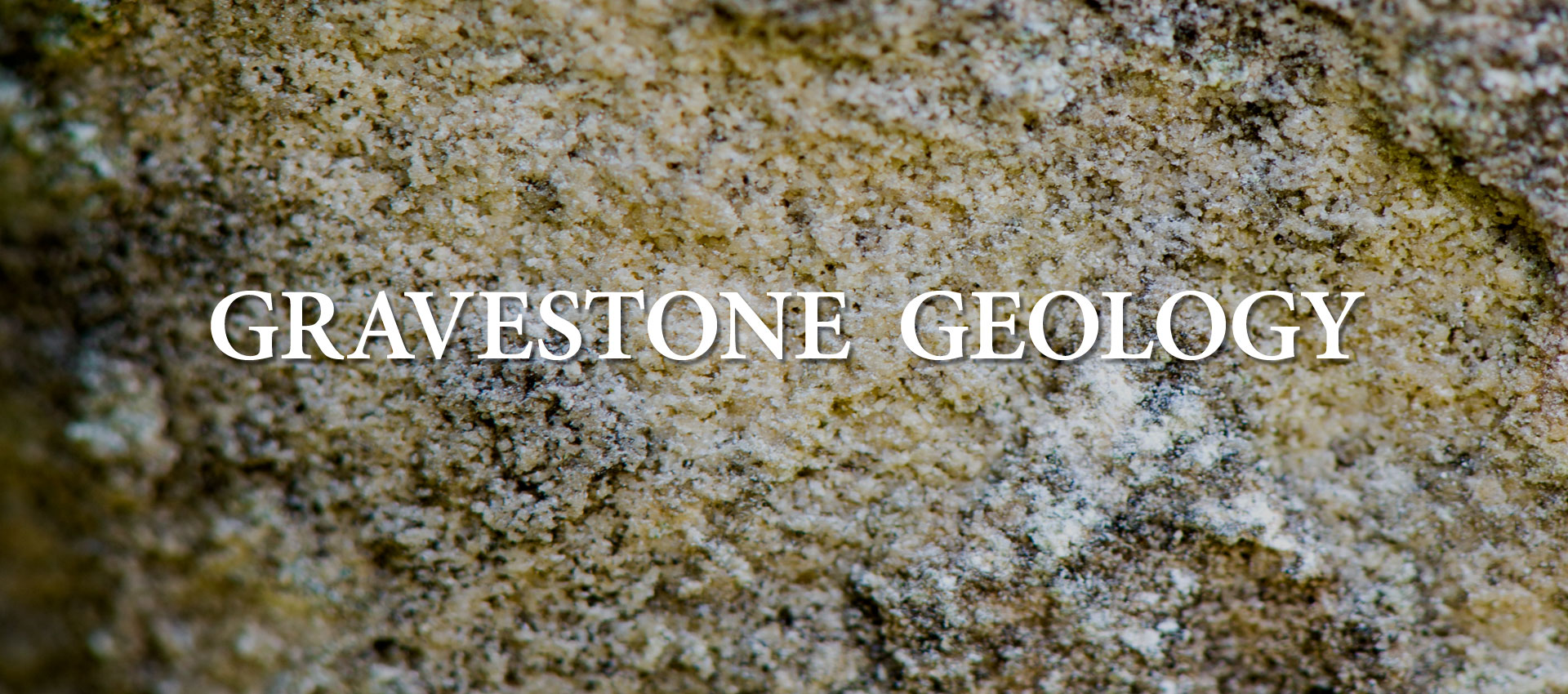Gravestone Geology
Cemeteries offer an excellent opportunity to examine a wide range of stone types in a small space.
Because gravestones are made from a wide variety of rock types formed in a range of geological settings, cemeteries can be geological treasure-troves. Many gravestones are made of polished stone, and so reveal details—such as minerals and crystal features—that are not easy to see elsewhere. Some demonstrate the textures and mineral composition of igneous rocks. Others are happy hunting grounds for lovers of fossils. Some gravestones reveal sedimentary structures that show how the rock was originally deposited. Others provide clues to Earth movements and environments that occurred hundreds of millions of years ago.

The graveyard of St Thomas the Martyr in Oxford.
A visit to a cemetery also offers a wonderful introduction to other sciences that underpin geology, such as chemistry and physics, and can serve as a source of valuable field data for engineers, architects and conservators. In addition, an examination of gravestones can provide useful information about topics ranging from the weathering of stone to atmospheric chemistry, the effects of pollution, stability and settling in soils, and land drainage. Gravestones are also great places to study lichens, and churchyards are often wonderful sites to enjoy wildflowers, observe insects, and take the opportunity to explore many aspects of natural history and environmental science.
Because of the difficulties involved in transporting stone over long distances, older churchyards and burial grounds tend to be the best places to study local stone because they often include gravestones dating from the seventeenth century or earlier, which are made of stone often dug from quarries just a few kilometres away.
Victorian cemeteries, developed at a time when the canal and rail networks were expanding, open up the potential for examining rock types from many parts of the British Isles. Now, thanks to the development of extensive world-wide transport networks, as well as power tools able to work even very hard stones, modern cemeteries offer an opportunity to examine rocks from all over the globe.
Facing the elements
In order to serve their primary purpose — that of commemorating the dead — gravestones must be able to remain in good condition for many years, generally without any maintenance. Because they are located outdoors and are thus subject to a wide range of environmental conditions, including the effects of wind, rain and snow, pollution, and the growth of lichens, moss, ivy and other plants on and around their surfaces, the choice of stone is important.
Sandstones, limestones, igneous and metamorphic rocks from all over the world are all commonly used for gravestones. Each has its advantages and disadvantages in terms of workability and durability. And all have interest from the geological point of view.
Sandstones

The inscription on this Upper Carboniferous Pennant Sandstone has weathered badly.
Sandstones exist in a variety of colours and textures. In some areas of the UK they are available from local quarries. Although sandstones do not generally polish to a sheen, for gravestones they have the advantage that they can be cut to present a flat, muted surface that takes an inscription well.
From a geological point of view sandstones can be an interesting choice because gravestones made of sandstone often exhibit a range of sedimentary structures, compositions, grain sizes and shapes and degrees of cementation, and so offer excellent opportunities for sedimentologists to speculate about their origin and transport mechanisms.
But as gravestones, sandstones present some problems. For example, when the stone is positioned with the bedding vertical, pressure or weathering along the top edge of the gravestone can force the stone open along its bedding planes, often exposing more friable surfaces to the effects of further weathering. Freeze and thaw of water entering the pore spaces— either through contact with soil or through layers cut by the inscription—is another common problem, which can cause sandstones to delaminate.
The crystallization of salts absorbed into pore spaces can also cause surface blistering. These two factors may be the reason why the inscriptions in some—but not all—older gravestones made from sandstone are damaged, or flaked off altogether.
Limestones
Many types of limestone, including oolitic and various fossiliferous limestones from the UK such as Purbeck Marble (actually a limestone) and Carboniferous crinoidal limestones, and more recently, fossiliferous limestones from abroad, are used as gravestones in Britain.

Henry Bird's elaborate limestone tomb in Holywell Cemetery in Oxford. The canopy is made of Middle Jurassic Forest Marble limestone, and the effigy is carved from Portland Stone, an Upper Jurassic limestone from Dorset.
From a geological point of view, gravestones made from limestones can offer wonderful opportunities to view fossils, study sedimentary features such as bedding and bioturbation, and speculate about the palaeoecology of ancient marine environments. As gravestones, limestones are relatively easy to carve and shape, so these gravestones are often very decorative. However, as monuments they are particularly prone to surface loss through weathering, especially due to acid rain, which can lead to blurring of the inscriptions.
From a geological point of view, though, weathering in limestone gravestones is not always a bad thing because it can reveal interesting features such as fossils standing proud of the surface. Weathering can also help to make some types of limestones effectively 'self-cleaning'.
For example, one reason that the Portland Stone, an Upper Jurassic oolitic limestone from the Isle of Portland in Dorset, was chosen by the Commonwealth War Graves Commission (CWGC) for use in its war graves is because the continual erosion of ooliths from the surface due to weathering reveals fresh, clean ooliths beneath, so the stone tends to retain its pale colour as it weathers and is thus easy to maintain.
Marbles

This headstone includes a violin, complete with strings, in St Sepulchre's Cemetery, Oxford. It is carved from marble.
Stone masons generally define marble as any limestone that can take a polish, but in geological terms, marble is a metamorphic rock formed when the action and heat and pressure on limestone buried deep in the Earth's crust causes the limestone to recrystallize to form tightly interlocking grains. Marble, generally from quarries near Carrara in Italy, became fashionable for use as gravestones in the nineteenth century and is still often used today.
The compact structure of marble means it can take a high polish and be carved into interesting shapes. But for geologists, marble gravestones are less interesting than gravestones made from limestones. Although weathering sometimes reveals areas where the original limestone was better cemented, the metamorphism tends to remove any traces of bedding features or fossils.
Slates
In geological terms slates are formed by the metamorphism of fine-grained sedimentary rocks composed of mud, clays or volcanic ash.

The inscription on this Welsh slate gravestone in St Sepulchre's Cemetery, Oxford remains clear and sharp after 150 years.
During metamorphism the clay minerals become aligned to produce a rock that splits, or cleaves, readily into thin parallel slices at an angle to the bedding, to form cleavage planes.
In the UK two different types of slate are commonly used for gravestones: Welsh slate, which originated from Lower Palaeozoic clays and mudstones; and Lake District slate, composed originally from Ordovician volcanic ash.
Slate is a hard rock—and because of its cleavage cannot be easily carved into three-dimensional shapes—so slate headstones are generally designed with simple profiles. However, because they are made of fine-grained sediments, slate gravestones take an inscription well, and the inscriptions often remain crisp and well preserved for many years.
Slate headstones tend to be set up with the cleavage planes vertical, and to the delight of sedimentologists, traces of the original sedimentary bedding and features, including fining-upward, load and slump structures and erosion surfaces are often clearly visible on the gravestone surface.
Granites and gabbros
In the geological sense, granites are defined as igneous rocks containing around 20 percent quartz and 65 percent feldspar along with smaller amounts of various dark-coloured minerals. Granite did not come into widespread use for gravestones until the second half of the nineteenth century when the technology for working granite was developed and when the rail network expanded to make it possible to bring in granites from Cornwall, Scotland, the Lake District and Northern Ireland, the main granite areas of the UK.

Finely etched decoration on a micro-gabbro gravestone in Headington Municipal Cemetery, Oxford.
But once it arrived, granite became very popular for use as gravestones because of its decorative features and durability. Many different types are used, and as a result for geologists granite gravestones offer an opportunity to examine a wide range of interesting features including crystal structure and zoning in feldspars, flow structures and xenoliths.
Although gabbros are often referred to as 'black granites' in the trade, they are not true granites and differ from granite in many ways. In geological terms, gabbros don't contain quartz; their main constituent is feldspar. Their dark colour is due to the high percentage of metal oxides and dark-coloured silicate minerals rich in iron and magnesium that they contain. Gabbros are found in many parts of the world, including the Isle of Skye in Scotland, but the gabbros most commonly used in gravestones tend to be microgabbros imported from southern Africa or India. These are composed of very small crystals and the stone can be polished to produce a shiny black surface which can take very finely etched decoration.
For geologists, gravestones made of these microgabbros are not very interesting, because it is difficult to see much of the crystal structure under a hand lens. But coarse-grained gabbros originating from magmas which were more deeply buried, and thus cooled more slowly, are a different story. These can reveal interesting mineral features under a hand lens, including large feldspar crystals, dark coloured pyroxenes and saussurite, an alteration product of the feldspar, which gives the stone a greenish tinge.
Gneisses and migmatites

Flow structures in a migmatite gravestone in Headington Municipal cemetery, Oxford.
Gneisses are banded, coarsely crystalline metamorphic rocks formed by high temperature and pressure deep in the Earth's crust. The banding, or foliation, is the result of a separation of dark-coloured minerals, such as biotite and hornblende, from lighter coloured minerals such as quartz and feldspar.
Migmatites are formed when gneisses subjected to extreme temperatures and pressures become fluid and the banding becomes disturbed by flow movements. These are preserved in the cooled and solidified rock as streaks, swirls and shear structures.
From the geological point of view, gravestones made of gneisses and migmatites are particularly fascinating, both for the range of minerals they contain—often clearly visible using a hand lens— which give clues as to the nature and origin of their parent rock, and for the striking and spectacular flow structures they exhibit.
These make it possible to speculate about the way the parent rock melted, flowed and was deformed during metamorphism.
Cemetery science
Aside from the opportunity cemeteries offer to study many different rock types and geological histories in a small space, gravestones are also being widely used for studying the effects of weathering on stone—a subject of great interest to those concerned with choosing stone for use as building stones, and with repairing and conserving the stone in older buildings.
Weathering is a complex series of processes resulting from continuous exposure to the elements. The damage inflicted on stone from weathering depends on the effects of changes of temperature, wind, rain and frost, as well the mineralogical composition of the stone, its porosity, texture, absorption and the way in which water concentrates on it. The rate of weathering is affected by factors such as levels of pollution, acid rain, salt contamination, bird droppings, and rising damp.
Some rock types withstand weathering effects better than others, so information about the way particular rock types weather is an important consideration when choosing stone for both the exterior walls of buildings as well as for gravestones. But the amount of weathering is also greatly influenced by variations in the microclimate around the stone—and graves located quite close to each other can react differently to the effects of weathering.
Although some types of stone used for gravestones— especially 'hard rocks' such as granites, gabbros, gneisses and migmatites—are less susceptible to weathering effects, in the end, weathering affects the appearance of all gravestones. As a result, gravestones are being used in a number of investigations designed to document the processes that affect weathering in building stones.
These studies draw on a methodology first proposed in the 1880s by the geologist Archibald Geikie (1835–1924), who realised the value of gravestones for monitoring weathering because the date when the gravestone was first exposed to the elements is generally precisely known and documented in the gravestone inscription. Moreover, information not only about the identity of the stone, and in some cases, even the quarry it came from was often available, and the environmental conditions in churchyards were relatively easy to monitor.
In a project now underway at the School of Geography and the Environment at Oxford University—one of several using gravestones as a tool for studying stone weathering—a group of surplus and uninscribed, standard issue war grave headstones made of Upper Jurassic Portland stone, have been erected in a field in Wytham Woods near Oxford.
The headstones are equipped with sophisticated monitoring devices to record how the stone responds to a range of environmental factors, providing a valuable dataset for the conservation and building stone industry. The knowledge gained from these studies will be used to govern the choice and conservation of stone used as building material.
The Oxford study is just one of several using gravestones as a tool for studying weathering in stone. While the main aim of these weathering studies is to assure the immortality of stone used in the built environment, as a side benefit, the studies also in some small way honour and ensure immortality for those buried beneath.
Nina Morgan

